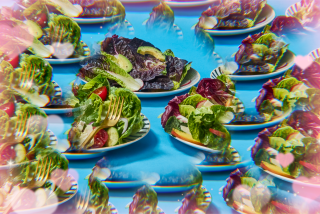Salad : Lettuce: Enjoy
- Share via
The salad bowl--a big, old ironstone washbasin with a wreath of roses around the edge--is full to overflowing with tender lettuces. Some are sweet and soft, others crisp and juicy. The colors are a tapestry of bright and dark greens, with hints of bronze, ivory and gold. The lightest veil of cream and lemon and a sprinkling of snipped chives is enough to dress the whole lot.
When it comes to home-grown lettuce, Alice B. Toklas had it right: “The first gathering of the garden in May of salads, radishes and herbs made me feel like a mother about her baby--how could anything so beautiful be mine?”
Look at them sparkling with dew in the morning light: the red-tinged frills of Lollo Rossa and emerald ovals of Little Gem, the chartreuse roses of old-fashioned Boston Bibb . . .
Just listen to Angelo Pellegrini. In “The Food Lover’s Garden,” now deservedly a classic, that ardent eater suggests harvesting lettuces when the heads are half grown--of good size and color but still firm and tender with youth. “Their very appearance then,” he says, “will tempt one to bend to the ground and eat them in the manner of a blissful ruminant.”
*
The lettuce list would just about fill the food section if every variety were named. There are hundreds, possibly thousands, from heat-tolerant Apollo to super-hardy Winter Marvel, but all are members of the same species, Lactuca sativa , one of the oldest vegetables in cultivation. Lettuce comes from the Latin word for milk ( lac ), because of the milky juice exuded by its leaves and stalks when cut.
Over time three main categories have been developed: L. sativa var. capitata , head lettuce (also known as cabbage lettuce, because of its tightly folded head); L. sativa var longifolia , romaine (also known as Cos, from the Greek island of Kos, its supposed home); and L. sativa var. crispa , leaf lettuce (also known as looseleaf, cutting lettuce or cut-and-come, because of its relaxed appearance and willingness to keep growing new leaves as fast as the outer ones are harvested.
Mesclun or Misticanza is not a single type of lettuce but a mixture of baby leaves, predominantly lettuce but often including cress, endive, dandelion, roquette, mustard, chervil and other herbs. Once unknown outside of fancy restaurants, mesclun is becoming widely available in produce sections, usually sold loose by the pound, sometimes packed in plastic bags. Be sure the leaves are whole and sound--some unscrupulous packers bulk out the mix with cut-up material, which shortens shelf life and should not command mesclun’s premium price.
There’s not much nourishment in lettuce, although the dark-green types do provide a bit of Vitamin A. Lettuce is, however, a famous soporific. If you demand that food have value beyond flavor, keep in mind the following, from “Kettner’s Book of the Table” (London, 1877):
*
“The chemists obtain from the lettuce an inspissated (condensed) juice--called sometimes lactucarium, sometimes lettuce-opium--which is said to allay pain, to slacken the pulse, to reduce animal heat, and to conduce to sleep. When Adonis died, it is reported that Venus threw herself on a lettuce-bed to lull her grief and cool her desires.”
Growing first-class lettuce is easy and quick. Buying it at the farmers market is even easier and quicker. The thing that matters is that the stuff be local. Except for iron iceberg and industrial-strength romaine, lettuce is delicate, a poor shipper and a poor keeper. Buy it fresh, keep it cold and eat it quickly.
*
Cream coats salad greens without making them soggy. Use balsamic vinegar if the greens have strong flavors, lemon if they’re more delicate.
CREAM DRESSING FOR TENDER GREENS
1/3 cup whipping cream, preferably not ultrapasteurized
2 tablespoons lemon juice or 3 tablespoons balsamic vinegar
1/2 teaspoon salt
1/8 teaspoon Dijon mustard
Tiny dash sugar, if using lemon juice
Beat cream, lemon juice, salt, mustard and sugar in bottom of bowl. Dressing will thicken as cream curdles. Add prepared greens and toss well, using fingers to avoid bruising leaves.
Makes about 1/2 cup dressing, enough for about 2 quarts of lightly piled tender salad greens, 4 to 6 generous servings.
Each 1-tablespoon serving contains about:
35 calories; 153 mg sodium; 14 mg cholesterol; 4 grams fat; 1 grams carbohydrates; trace protein; trace fiber.
More to Read
Eat your way across L.A.
Get our weekly Tasting Notes newsletter for reviews, news and more.
You may occasionally receive promotional content from the Los Angeles Times.










